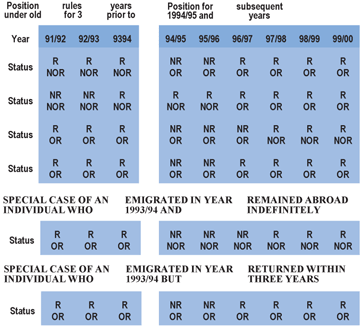Revenue Tax Briefing Issue 15, July 1994
3. Residence of Individuals
Introduction
Practitioners will be aware that the Finance Act 1994 introduced significant changes in the rules governing residence of individuals. A copy of leaflet RES.1 recently produced by the Revenue Commissioners is included with this edition of Tax Briefing. It sets out those changes in general terms. It was felt, however, that a more precise statement on aspects of those changes might be useful to practitioners.
Sec. 151 Finance Act 1994 - “Ordinary Residence”
Section 151 F.A. 1994 deals with “ordinary residence” of an individual for 1994/95 and subsequent years.
The “ordinary resident” status of an individual for the year 1993/94 is however a further determining factor in deciding the “ordinary resident” status for 1994/95 and subsequent years. For instance, where an individual was “ordinarily resident” for 1993/94 and subsequent years, unless the individual was resident for each of the three preceding tax years.
The above sets out the general position. However, that does not apply in the case of an individual who left the State on or before 5 April 1994 with the intention of making a permanent home in another country. Under the old rules, such an individual provisionally ceased to be “ordinarily resident” from the date of departure. This status is unaffected by the new provisions (notwithstanding the contrary impression, which might arise by reading section 151(1) in isolation) provided the individual remains non-resident in the three years following the year of departure. At the end of that period, the cessation of “ordinary residence” is confirmed and the individual will be treated as not having been “ordinarily resident” for each of those three years. If, however, the individual becomes resident in any one of the three years following the year of departure, “ordinarily residence” is deemed never to have ceased and in such circumstances the provisions of section 151(2) will then apply in determining the individual’s “ordinary residence” status for 1994-95 et seq.
Residence and Ordinary Residence 1994/95 and Subsequent Years
The table below show how an individual’s RESIDENCE and ORDINARY RESIDENCE status for tax year 1994/95 and subsequent years can be effected by the record of RESIDENCE AND ORDINARY RESIDENCE in years 1991-1994.
Abbreviations:
R: Resident
OR: Ordinarily Resident
NR: Not Resident
NOR: Not Ordinarily Resident

Repeal of Section 76(4) 1967 by Section 157 F.A. 1994
Section 157 FA 1994 has repealed Section 76(4) ITA 1967 in respect of the year 1994/95 and later years. Subsection (2) of the section provides for a transitional relief to apply where the Revenue Commissioners are satisfied that the repeal of Section 76(4) would cause hardship.
Relief under Section 76(4) ITA applied in respect of income chargeable to tax under Case III Schedule D from an employment exercised wholly outside the State.
In practice, the relief under Section 76(4) was allowed by confining the tax charge to the element of such income remitted to the State. It must be emphasised, that the new relief is distinct from the relief which applied in practice under Section 76(4).
Application of Section 157(2) F.A. 1994
Section 157(2) gives a measure of flexibility so as to allow relief, for 1994/95 only to a person who as a result of the repeal of Section 76(4) suffers hardship. In practice, where the terms of an existing contract between an employer and employee are such that either party suffers hardship by loss of relief under Section 76(4), relief for that hardship may be claimed by the employee under Section 157(2). In calculating the maximum relief which will be allowed under Section 157(2) the disallowance of the first 15 qualifying days (provided for in Section 154 F.A. 1994) will be applied on a pro rata basis, thus if the number of qualifying days in 1994/95 is 60, the restriction will be two thirds of 15 i.e. 10 days.
The relief will be given by repayment of tax at the end of the tax year, but approval in principle may be obtained in advance, where claims are based on already agreed contracts. Claims should be made to the PAYE District dealing with the employer’s PAYE affairs. Details of the hardship claimed to have been suffered by the repeal of Section 76(4) must be provided. Such details would normally include evidence that the contract terms agreed assumed the availability of relief under Section 76(4)
.
